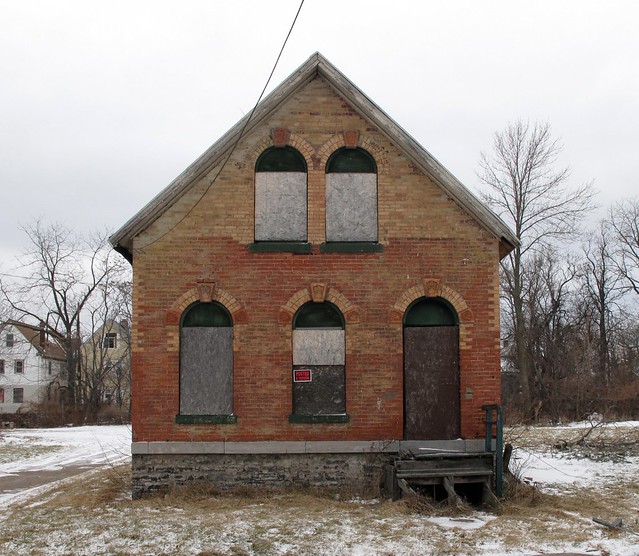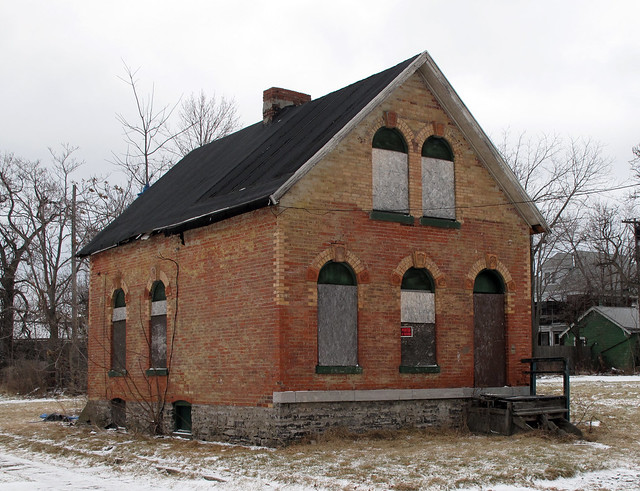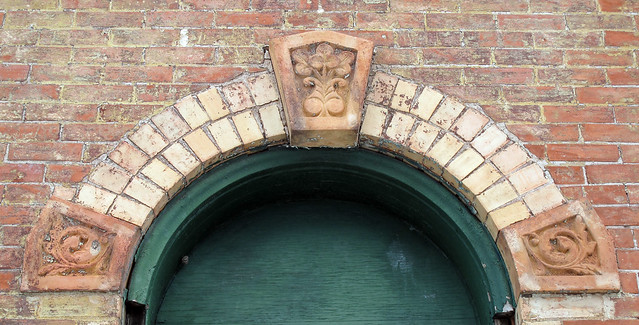This is the first part of a new monthly series focusing on heritage properties that the City of Buffalo owns and has abandoned. Every month a new property will be featured, hard questions will be asked and regular monthly updates will present an on-going status report.
16 Harwood Place is cool. There are only two residential structures in the Hamlin Park Historic District that incorporate structural and ornamental materials that were manufactured by the J. Lyth & Sons Tile Company, with production facilities located across the street - here. The first is the Lyth family home - and the second is this lovely brick and terra-cotta cottage which stands directly behind the family's house.
The City acquired Lyth Cottage in 1997. This map shows its proximity to Mayor Brown's residence and Canisius College, a few blocks away.
In late 2007 the City's three major preservation organizations, in conjunction with the National Trust for Historic Preservation, commissioned a study - Buffalo Historic Preservation Issues and Opportunities Assessment (.pdf) - by Elizabeth Waters. The ten page document was widely circulated and read in the local preservation community when it was released two years ago. Her findings are presented along four lines: strengths, weaknesses, challenges and opportunities. The following passage was identified as a major challenge in Buffalo:
An embarrassment of riches. Like a number of other historic cities in the northeast and mid-west that have lost substantial population, Buffalo has a very large stock of historic resources relative to its population. The number of historic structures exceeds the number the population and economy will be able to rehabilitate and reuse in the foreseeable future. This places great pressure on the preservation community and the city to determine what it is most important to preserve and how to do it.
In the context of some staggering recent losses - the City-owned Wollenberg Grain Elevator (2006) and the Woodlawn Row Houses (2009) - and in light of the fact that the National Trust's annual conference will be held in Buffalo next year - the obvious question is: where's the plan? While emerging community-wide support for the landmarking of the Statler Hotel is developing (and should) what is currently being done to protect the heritage properties that have already been designated as landmarks? If the City's major preservation organizations agree with Elizabeth Waters and the findings presented in her February 2008 report, certainly Lyth Cottage deserves additional attention and protection.
click image to enlarge
Preservationists should be demanding that the City showcase this property. At a minimum, the online catalog of City-owned property available for sale should include Lyth Cottage. It doesn't. Why? Architecturally and historically Lyth Cottage is the most unique residential structure the City of Buffalo owns. With the exception of its local landmark status it is physically unprotected and as of yesterday, it remains unsecured.
Over the past few years Lyth Cottage has been shown to a number of qualified prospective buyers. Estimates begin at $50-75K to stabilize the shell - new roof, windows, doors, etc... - another $15-20K for new electrical and plumbing with a range of interior finishes waiting for you and your check book. Preservation standards aren't as restrictive as you might expect and allow for significant design flexibility if you can imagine a more modern addition to this place. If you're looking for a renovation project that intersects with the City's industrial and residential heritage, Lyth Cottage might be your place.
New locks have been installed on the back door, if you're interested in taking a closer look, please get in touch.
See the Lyth Cottage archive for more additional posts and pics.
__________________________________________________________________________
building index • fixBuffalo flickr • creative class • shrinking cities • americansuburbX
spacing toronto • infrastructurist • inhabitat
building index • fixBuffalo flickr • creative class • shrinking cities • americansuburbX
spacing toronto • infrastructurist • inhabitat









7 comments:
Standing upright, too. More-or-less architecturally intact. Cute little house. I'm convinced that so many issues with Buffalo's housing rot stems from the fact that the housing stock is dominated by frame structures. Those old frame houses were much easier to "improve" with asphalt or vinyl siding, aftermarket windows and wrought iron than brick structures,
It is absurd that this property is not featured in the City catalog, but that could be said about most city owned property.
The real tragedy is that the more this building is focused upon, or is in the current spotlight of attention, it is only a matter of time before some nutcase decides to light it aflame.
Perhaps ignoring this little bungalow would be wise until someone with the financial means and open-mindedness, to reside in a less-than-desirable location, comes along.
Could it be moved to a desirable location elsewhere in the city?
Eisenbart
What is the NY State municipal responsibility for disposition of property that it owns?
I have a vision...
A community garden. The house doesn't have to be livable, just stablize the shell and use it as a glorified garden shed. Rally the neighborhood to farm the space & pay for the repairs. People can pay for the produce grown there with money or sweat. Start a program with the local Juvenile Court to get youth that need to fulfill community service hours to work in the garden. Throw a fundraiser. Get local businesses to donate items & auction them off to pay for garden expenses. Set up a rainwater catchment system to save on the water bill. Make it a community effort. Many hands make light work.
Did this house sell!? Nooooooooo!!!!!!! That was supposed to by MY house! I saw on your flickr set that there was a new owner. Please, please, please give us an update!
Post a Comment